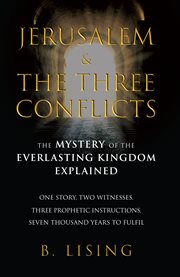Nonfiction
eBook
Details
PUBLISHED
Made available through hoopla
DESCRIPTION
1 online resource
ISBN/ISSN
LANGUAGE
NOTES
This book is about the heavenly kingdom, and this glorious eternal kingdom has a name: Jerusalem. It is about the gospel and the grand scheme of things. Here we will connect all the dots, and we will be able to see the big picture. There is only one story to tell, and two witnesses were chosen. There is only one prophecy but three prophetic instructions, and the completion will take seven thousand years. The gospel is not just the power of God for salvation, but also a complete message that can provide answers to all suitable questions. The gospel is the one and only connection we have from eternity. This means that the only way we can know our origin and purpose is to see the whole account of the gospel. The initial fulfilment of the gospel is the First Coming of the Lord Jesus, the middle fulfilment is the Holy Spirit, and the completion is the new Jerusalem (in sequence with the Second Coming). Knowing the end part is imperative to understanding the middle part and the beginning. As affirmed in Scripture, the new Jerusalem is the end part and the final stage of our foretold journey. When preaching the gospel, churches today rarely mention the new Jerusalem, if they mention it at all. It is true that the Lord Jesus is the center of the gospel, but we also need to know that the reason the only begotten Son of God had to go through all the sufferings was for us to become part of the new Jerusalem. This is why the Lord Jesus, after His resurrection, needed to leave His disciples and return to the Father. He must do something necessary before coming back for the Church. This is in relation to the new Jerusalem. What then is the connection between the new Jerusalem and the Gospel? This is a very serious question. Not knowing the link between the two is also a very serious issue. In contrast, knowing the connection will help us discover our beginning and our purpose. If the new Jerusalem is the end, then the first Jerusalem is the starting point. The new Jerusalem is, in fact, the re-establishment of the first (heavenly) Jerusalem. Does this mean that something happened to the first one so there was a need to create a new one? We can know this if we see the entire gospel account. The Gospel is all about Jerusalem, which was conquered and enslaved by Canaan, Egypt, and Babylon. But what do these three conflicts represent? Knowing the answer to this question will help us to understand the mystery of the Everlasting Kingdom, the gospel, and the grand scheme of things. In eternity past, the first Jerusalem was brought to ruin because of the Canaan conflict. In eternity future, God's promise of restoration is New Jerusalem. But first we needed a temporary escape, which is Egypt (the inside of time). Inside of time, the Babylon conflict would be the figurative representation of the Canaan conflict. It is no easy task to put together the universal truth of God's word and what it means in a way that is approachable for even those with little more than a cursory understanding of the Bible. It can feel overwhelming and uncomfortable, not so much for what it says but for what many of us seem to believe it does not say. B. Lising flips this coin in a way that we understand how there really is nothing that is not said, and the Scripture is only confusing because we have made it feel that way. The author delves into questions most of us have had at one time or another: Who are we? Where did we come from? What is our purpose in life? According to Lising, the answers to these and similar questions lie in our origins, and our origins are explained in the Bible. The entirety of the Gospel explains where we came from and what our purpose is here on planet Earth, and Revelation is a synopsis of the Bible, housing the answers to the mysteries and questions we have while revealing the grand scheme of things
Mode of access: World Wide Web







